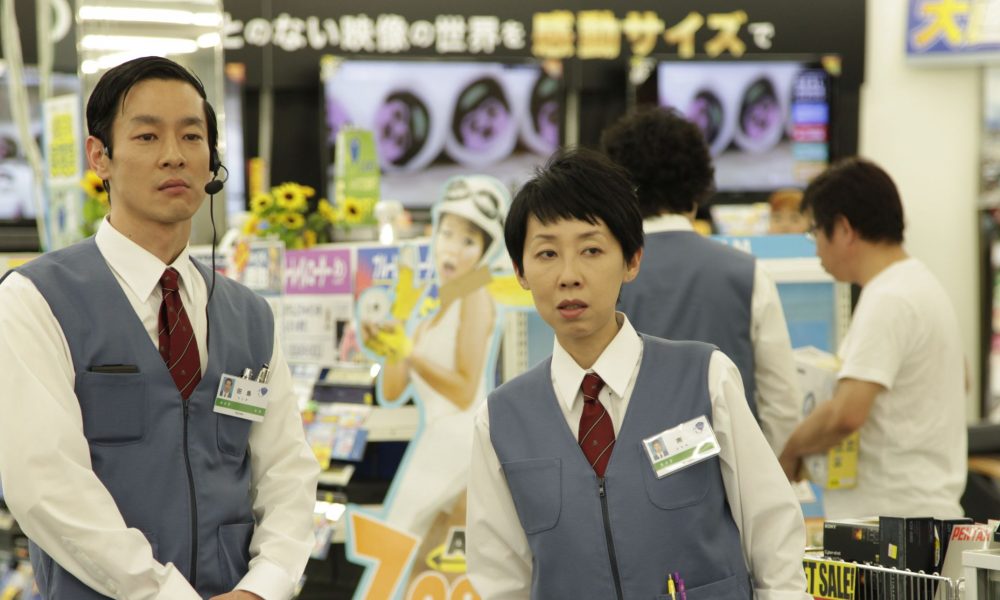By Chlotrudis Independent Film Society
Rating: 3.75 cats
Director: Satoshi Miki

Original language title: Ore Ore
Country: japan
Year: 2013
Running time: 119
IMDB: http://www.imdb.com/title/tt2390301/combined
Jason says: “There’s clear intent to make a clever movie in IT’S ME, IT’S ME from the opening shots of identical buildings, insistent posters about a rat infestation, and other bits that tie into the high concept of a young man multiplying across the city which seem to have started with some form of identity theft. Unfortunately, screenwriter/director Satoshi Miki stumbles putting the strange concepts together, and the movie has a hard time becoming more than a set of well-executed moments.
“The young man in question is Hitoshi Nagano (Kazuya Kamenashi), one of those anonymous protagonists who starts out pondering a jump from a bridge because there doesn’t seem to be much chance of life offering a better alternative. Instead, he goes to a restaurant and takes off with the phone of one Daiki Hiyama – a salary man about his age who placed it on Hitoshi’s tray because he didn’t notice Hitoshi was there – eventually running a scam on the man’s mother, but when he feels guilty and attempts to return the money, Daiki’s mother (Keiko Takahashi) recognizes him as her son. Then, when he goes to see his mother (Midoriko Kimura), there’s someone visiting who looks exactly like him! Hitoshi and Daiki find another guy with their face, student Nao Motoyama, and soon it seems like other people are becoming Hitoshi as well. As he starts spending more time with Daiki and Nao, he also finds himself flirting with Sayaka (Yuki Uchida), a married customer at the store where he sells cameras.
“Throughout the movie, Miki seem to be poking at the idea of urban anonymity and/or how having a group of friends that are just like oneself is seductive but ultimately unrewarding He and original novelist Tomoyuki Hoshino have certainly found an interesting way to make these concepts literal, but I’m not sure it’s much more than a clever idea. What is Miki really saying about swarms of people becoming effectively interchangeable? That eventually the delight of finding someone who gets you can be diluted to the point where a person can suddenly feel anonymous again? That (perhaps as a result) it’s a thing that leads to cutthroat competition? Is it all a reference for him giving up his dream of being a photographer and working in a big-box store (it’s worth noting that the best thing to happen in his life comes from Sayaka wanting him to take pictures)? Maybe, although the presentation of it is so fantastical and fuzzy that it’s hard for the metaphor to really shine through.
“That’s in part because the mechanism for the change and the details of it are too mysterious; aside from the initial identity-theft situation seeming sort of backwards, it’s often not quite clear whether the new Hitoshis remember their old lives or not. The evolution into a sort of thriller in the second half as the population of duplicates gets out of control and starts getting culled has similar issues. It’s a sharp turn about two-thirds of the way through the movie that may take a fair amount of post-viewing rationalization to seem to be about themes or plot machinations, but rather one of several sketched-out ideas that Miki and the original novelist played with until they couldn’t find anywhere else to go.
“The story’s meander does not mean that the viewer shouldn’t overlook the impressive work by Kazuya Kamenashi, a pop singer playing the lead role(s) with style; there’s just enough similarity and difference between the various versions of Hitoshi to make the situation interesting regardless of the story’s weaknesses. He also makes Hitoshi-prime (or at least, the guy we assume is the original Hitoshi Nagano) an amiable enough character, much more likable and fully realized than this sort of sad sack could seem to be otherwise. A lot of the most memorable moments have Kamenashi playing against himself, but there’s a nice supporting cast when one is necessary – Ryo Kase, Ryu Nakatani, and especially Eri Fuse bounce off him well as his co-workers, for instance. Yuki Uchida makes for a fun and unusual love interest – a little older and thus with her enthusiastic infatuation a little tempered; she’s got her own story that intersects with Hitoshi’s but isn’t completely subservient to it.
“Still, a lot of the appeal is watching multiple Hitoshis play off each other, and Miki and company have a good time sewing the effects together – the interactions between the Hitoshis are occasionally more showy than seamless, but those are funny moments. For a movie that doesn’t look particularly slick – much of it seems to take place in the same sort of lower-middle-class neighborhoods as Miki’s wonderful ADRIFT IN TOKYO, there’s a lot of attention to detail in the production, whether in the invisible visual effects or the parallel story that the posters detailing a rodent problem in the background seem to tell. Miki’s a talented-enough director that every scene, at least, seems to fit together as a unit, even if the whole becomes shaky.
“Less shaky than I originally thought, though – writing this almost a month after seeing the movie, it seems to be much richer and well considered than it did at the time. I somewhat doubt that different circumstances would make it a more immediately entertaining movie, but there’s certainly at least enough interesting elements on the surface to make it worth digging into. 3.75 cats (but, you know, it was my fourth movie of the day and who knows what number I’d assign to it if I just sat down to watch this movie by choice rather than the arbitrariness of a festival schedule)
“Seen 20 July 2013 in le Cinéma Impérial (Fantasia Festival Camera Lucida, HD).”
| It’s Me It’s Me (Japan; 119 min.) directed by: |
 |
